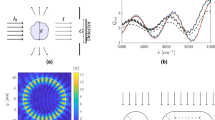Abstract
Infrared spectroscopy has attracted considerable attention at many fields of study such as pharmaceutical sciences. How much scattering we have would be based on the similarities range of mid-infrared wavelength and uneven biological samples like cells and tissues. In such cases, the part of the input irradiance wave which does not reach the detector could erroneously be interpreted as absorption intensity. So it shows itself as a broad sinusoidal oscillation in the baseline, and even it would have frequency shifts in the absorbance bands. Based on the studies conducted in this area, the main cause of spectral distortion is the Resonant Mie Scattering. In other words, the real refractive index spectrum plays a prominent role in high scattering. However, pure absorptive components extraction suffers from requiring an appropriate reference spectrum for initialization. It must not contain any scattering contributions which unfortunately cannot be always happened. In this article, a cost function under a clear constraint is presented with regard to the biological data and the scattering structure to spectrum correction. The results show that the creation of eligible cost function using optimization algorithms could have the desired accuracy for biological spectra even without selecting appropriate reference spectrum.











Similar content being viewed by others
References
Pavia, D. L., Lampman, G. M., Kriz, G. S., & Vyvyan, J. A. (2008). Introduction to spectroscopy. Belmont, CA: Cengage Learning.
Ostrovsky, E., Zelig, U., Gusakova, I., Ariad, S., Mordechai, S., Nisky, I., et al. (2013). Detection of cancer using advanced computerized analysis of infrared spectra of peripheral blood. IEEE Transactions on Biomedical Engineering, 60(2), 343–353.
Bassan, P., Kohler, A., Martens, H., Lee, J., Byrne, H. J., Dumas, P., et al. (2010). Resonant Mie scattering (RMieS) correction of infrared spectra from highly scattering biological samples. Analyst, 135(2), 268–277.
Bassan, P., Kohler, A., Martens, H., Lee, J., Jackson, E., Lockyer, N., et al. (2010). RMieS-EMSC correction for infrared spectra of biological cells: Extension using full Mie theory and GPU computing. Journal of Biophotonics, 3(8–9), 609–620.
Diem, M., Miljković, M., Bird, B., Chernenko, T., Schubert, J., Marcsisin, E., et al. (2012). Applications of infrared and Raman microspectroscopy of cells and tissue in medical diagnostics: Present status and future promises. Journal of Spectroscopy, 27(5–6), 463–496.
Mohlenhoff, B., Romeo, M., Diem, M., & Wood, B. R. (2005). Mie-type scattering and non-Beer-Lambert absorption behavior of human cells in infrared microspectroscopy. Biophysical Journal, 88(5), 3635–3640.
Bassan, P., Byrne, H. J., Lee, J., Bonnier, F., Clarke, C., Dumas, P., et al. (2009). Reflection contributions to the dispersion artefact in FTIR spectra of single biological cells. Analyst, 134(6), 1171–1175.
Dazzi, A., Deniset-Besseau, A., & Lasch, P. (2013). Minimising contributions from scattering in infrared spectra by means of an integrating sphere. Analyst, 138(14), 4191–4201.
Baker, M. J., Trevisan, J., Bassan, P., Bhargava, R., Butler, H. J., Dorling, K. M., et al. (2014). Using Fourier transform IR spectroscopy to analyze biological materials. Nature Protocols, 9(8), 1771.
Mie, G. (1908). Beiträge zur Optik trüber Medien, speziell kolloidaler Metallösungen. Annalen der Physik, 330(3), 377–445.
Hulst, H. C., & van de Hulst, H. C. (1957). Light scattering by small particles. North Chelmsford: Courier Corporation.
Romeo, M., Mohlenhoff, B., & Diem, M. (2006). Infrared micro-spectroscopy of human cells: Causes for the spectral variance of oral mucosa (buccal) cells. Vibrational Spectroscopy, 42(1), 9–14.
Bassan, P., Byrne, H. J., Bonnier, F., Lee, J., Dumas, P., & Gardner, P. (2009). Resonant Mie scattering in infrared spectroscopy of biological materials–understanding the ‘dispersion artefact’. Analyst, 134(8), 1586–1593.
Bassan, P. (2011). Light scattering during infrared spectroscopic measurements of biomedical samples (Doctoral dissertation, University of Manchester).
Ogilvie, J. F., & Fee, G. J. (2013). Equivalence of Kramers Kronig and Fourier transforms to convert between optical dispersion and optical spectra. Mathch-Communications in Mathematical and in Computer Chemistry, 69(2), 249–262.
Martens, H., Nielsen, J. P., & Engelsen, S. B. (2003). Light scattering and light absorbance separated by extended multiplicative signal correction. Application to near-infrared transmission analysis of powder mixtures. Analytical Chemistry, 75(3), 394–404.
Kohler, A., Sule-Suso, J., Sockalingum, G. D., Tobin, M., Bahrami, F., Yang, Y., et al. (2008). Estimating and correcting Mie scattering in synchrotron-based microscopic Fourier transform infrared spectra by extended multiplicative signal correction. Applied Spectroscopy, 62(3), 259–266.
Duarte, L. T., Moussaoui, S., & Jutten, C. (2014). Source separation in chemical analysis: Recent achievements and perspectives. IEEE Signal Processing Magazine, 31(3), 135–146.
Whittaker, K. A., Keaveney, J., Hughes, I. G., & Adams, C. S. (2015). Hilbert transform: Applications to atomic spectra. Physical Review A, 91(3), 032513.
Bertie, J. E., & Zhang, S. L. (1992). Infrared intensities of liquids. IX. The Kramers-Kronig transform, and its approximation by the finite Hilbert transform via fast Fourier transforms. Canadian Journal of Chemistry, 70(2), 520–531.
Diem, M. (2015). Modern vibrational spectroscopy and micro-spectroscopy: Theory, instrumentation and biomedical applications. New York: Wiley.
Konevskikh, T., Lukacs, R., Blümel, R., Ponossov, A., & Kohler, A. (2016). Mie scatter corrections in single cell infrared microspectroscopy. Faraday Discussions, 187, 235–257.
Bassan, P., Sachdeva, A., Kohler, A., Hughes, C., Henderson, A., Boyle, J., et al. (2012). FTIR microscopy of biological cells and tissue: Data analysis using resonant Mie scattering (RMieS) EMSC algorithm. Analyst, 137(6), 1370–1377.
Author information
Authors and Affiliations
Corresponding author
Rights and permissions
About this article
Cite this article
Barzegari Banadkoki, S., Torkamani Azar, F. & Hosseini Shirazi, F. Estimation and Reduction of Resonant Mie Scattering (RMieS) From IR Spectra of Biological Cells by Optimization Algorithm. J. Med. Biol. Eng. 39, 431–441 (2019). https://doi.org/10.1007/s40846-018-0423-9
Received:
Accepted:
Published:
Issue Date:
DOI: https://doi.org/10.1007/s40846-018-0423-9




